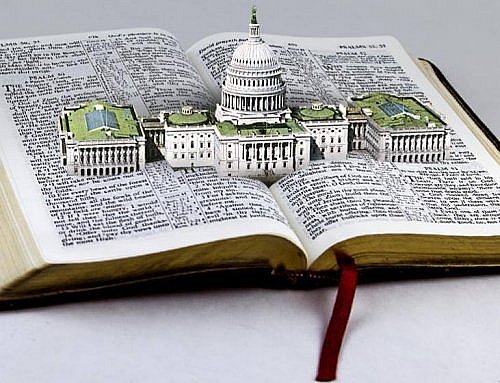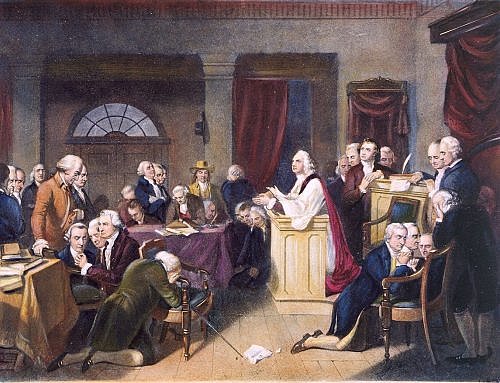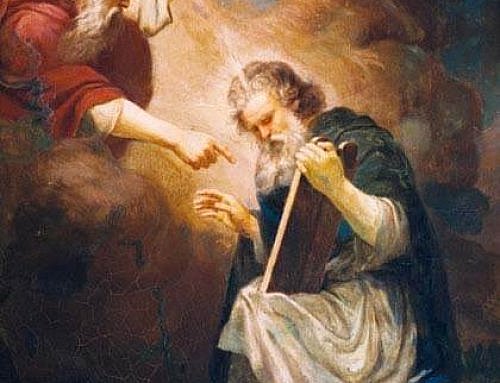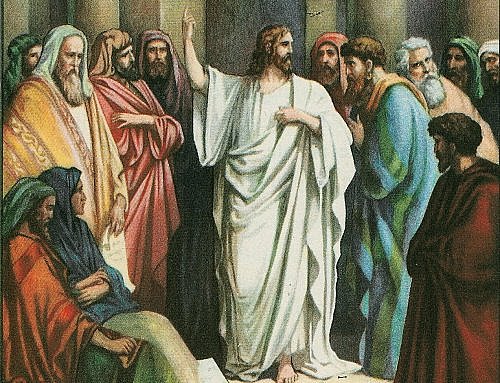by David J. Vaughan
The debate over the relationship of church and state in America hinges on the interpretation of the establishment clause of the First Amendment. That clause reads: “Congress shall make no law respecting an establishment of religion, or prohibiting the free exercise thereof…..” There are two differing interpretive methodologies employed in the reading of the First Amendment, each of which yields a different interpretation of its meaning.
The first, known as intentionalism, posits that judges should confine themselves to enforcing values which are expressed, or clearly implicit, in the written Constitution. Judges should seek to implement the purposes or intentions of the framers. However, if the framers’ intent is unclear, then legislative bodies, not the court, should determine which values will be placed into law. The opposing methodology, non-interpretivism, claims that judges should go beyond the words and intentions of the framers; and that the Constitution is intentionally vague in order to allow for a broad interpretation. The non-interpretivist view leads naturally to a broad or separationist interpretation of the First Amendment. Accordingly, church and state (both federal and state) should be completely independent and absolutely separate. Thus, government aid to religion, even if on a non-preferential basis, violates the First Amendment. Mr. Justice Black, writing for the United States Supreme Court, has expressed the broad view thus: “The ‘establishment of religion’ clause of the First Amendment means at least this: Neither a state nor the Federal Government can set up a church. Neither can pass laws which aid one religion, aid all religions, or prefer one religion over another…The First Amendment has erected a wall between church and state. That wall must be left high and impregnable. We could not approve the slightest breach”. (Everson, 330 U.S. 1 (1947), emphasis added.) On the other hand, intentionalism leads to a narrow or non-preferential interpretation of the establishment clause. The purpose of the First Amendment was to prevent Congress (the federal or national government) from establishing a national church or religion, thereby granting one church or denomination preferred statue. It guaranteed to the respective state governments, however, the prerogative of legislating on religious establishments and institutions as they saw fit.
Intentionalism, then, suggests that the First Amendment was not written in order to create a religiously neutral or “secular” state. The framers, many of whom were religious men, did not intend a moral separation between religion and government, but merely an institutional separation of church and state on the federal level. In other words, they did not design to isolate the government or society from religious influences. Most importantly, the express purpose of the First Amendment was the free expression of religion. It was not written as a constraint on religion, but as a constraint on the National Government. As James Madison said “There is no shadow of right in the general [Federal] government to intermeddle with religion….This subject is… perfectly free and unshackled. The government has no jurisdiction over it.” Thus, non-preferential aid to all religious would not violate the First Amendment.
The evidence for the intentionalist view of establishment clause is convincing. Firstly, the Constitution provides for a national government of strictly delegated powers. Those powers not expressly granted to the federal government are reserved to the states. This principle is known as the doctrine of Express Powers. Therefore, even without the First Amendment, the federal government cannot legislate on religion because the Constitution nowhere grants to it that power. Religious legislation then is reserved for the States. Indeed, in 1775 at the outbreak of the Revolution, nine of the 13 colonies had established churches. As Justice Hand wrote for the Court:
At the beginning of the Revolution established churches existed in nine of the colonies…The first amendment in large part was a guarantee to the states which insured that the states would be able to continue whatever church-state relationship existed in 1791. Maryland, Virginia, South Carolina, and Georgia all shared Anglicanism as the established religion common to those colonies. Congregationalism was the established religion in Massachusetts, New Hampshire, and Connecticut. New York, on the other hand, allowed for the establishment of Protestant religions. Only in Rhode Island and Virginia were all religious sects disestablished. But all of the States still retained the Christian religion as the foundation stone of their social, civil, and political institutions. Not even Rhode island and Virginia renounced Christianity, and both states continued to respect and acknowledge the Christian religion in their system of law.
Even where no church was officially “established”, Protestant Christianity was the recognized and legally preferred religion. As historian R.J. Rushdoony has noted; “there were religious requirements for citizenship and suffrage, religious oaths, laws prohibiting blasphemy, laws requiring a Trinitarian faith, or a firm belief in the infallibility of Scripture, and laws barring unbelievers as witnesses in courts”. (The Nature of the American System, p.4) The legal historian and Rhodes scholar, Daniel Dreisbach, clarifies the role of the First Amendment vis-a-vis the states. “The First Amendment was a guarantee to the states which ensured that the state governments would be able to continue whatever church-state relationships existed in 1791. In short, Congress was foreclosed from interfering with existing state establishments of religion.” (Real Threat and Mere Shadow, p.78)
The first Congress, which framed the First Amendment, was a body of predominantly religious men who believed in Christianity. Fifty two (52) of the fifty five framers were members of a Christian church. As constitutional scholar John Eidsmoe has pointed out:
It is possible some of the delegates belonged to other churches and might have held deist convictions. But as a condition for church membership, most colonial churches required sworn adherence to strict doctrinal creeds, which included belief in the Bible as God’s revelation and trust in Jesus Christ as the Son of God. If the founding fathers held deist ideas while belonging to Christian churches it means they swore falsely in the presence of God. (Christianity and the Constitution, p.43)
These men would hardly have framed an amendment which they thought harmful to their religion. Moreover, the first Congress resolved to pay a chaplain with federal monies, to open their sessions with prayer; and resolved, only hours after the adoption of the First Amendment, to petition the President to issue a proclamation setting aside a day of public thanksgiving and prayer. The Northwest Ordinance, passed in 1787, also provided federal tax monies for religious education. The framers themselves, then, saw no problem with the federal government co-operating with the Christian religion. Even Thomas Jefferson, the famous (or should we say infamous) author of the “wall of separation” phrase, did not believe the First Amendment forbade government aid to religion. For example, in 1796 Congress enacted a law entitled “An Act Regulating the Grants of Land appropriated for Military Services and for the Society of the United Brethren, for Propagating the Gospel Among the Heathen” (emphasis added). This law provided federal monies for payment to Christian missionaries. Yet Thomas Jefferson signed it into law on three separate occasions! He also signed a treaty with the Kaskaskia Indians (1807) which provided money to build a Christian church and for other religious needs. These acts were part of a tradition, which began with Washington, of civilizing the Indians by teaching them Christianity. According to President John Quincy Adams (1828), the Indians were “considered savages, whom it was our policy and our duty to use our influence in converting to Christianity and in bringing within the pale of civilization.”
By 1896, Congress was appropriating annually over $500,000 in support of sectarian Indian education carried on by religious organizations. (See J.M. O’Neill, Religion and Education Under the Constitution) After the colonies declared independence from Great Britain, Jefferson and several other prominent Virginians were appointed to a committee to revise the laws of Virginia. The committee began work in 1776, but it was not until the October 1785 session of the Virginia Assembly that the Revisals were submitted as a whole. Bill #84, entitled “A Bill for Punishing Disturbers of Religious Worship and Sabbath Breakers”, forbade employment on Sunday, or the Sabbath, on pain of a fine. Bill #85 authorized the Virginia Assembly to “appoint days of public fasting and thanksgiving”. But the most surprising bill of all is #86, which is entitled, “A Bill Annulling Marriages Prohibited by the Levitical Law”. In effect, Jefferson here codified into civil law, chapters of the Old Testament book of Leviticus. A recommendation such as this would hardly have come from someone who believed that the First Amendment required a “secular” state.
Intentionalism and a nonpreferential interpretation of the establishment clause seems best to accord with the historical evidence. Joseph Story (1779-1845), Associate Justice of the United State Supreme Court, has ably summarized the chief intent of the First Amendment.
The real object of the First Amendment was not to countenance, much less to advance, Mahomedanism, or Judaism, or infidelity, by prostrating Christianity; but to exclude all rivalry among Christian sects, and to prevent any national ecclesiastic establishment which should give to a hierarchy the exclusive patronage of the national government. It thus cut off the means of religious persecution (the vice and pest of former ages), and of the subversion of the rights of conscience in matters of religion which had been trampled upon almost from days of the Apostles to the present age…Probably at the time of the adoption of the Constitution, and of the first amendment to it… the general, if not the universal, sentiment in America was that Christianity ought to receive encouragement from the State, so far as was not incompatible with the previous rights of conscience and the freedom of religious worship. An attempt to level all religions and to make it a matter of state policy to hold all in utter indifference would have created universal disapprobation, if not universal indignation. (Commentaries on the Constitution of the United States, sec.1874,1877)
The establishment clause of the First Amendment, therefore, was not designed to create a secular state. Rather, the framers were religious men who desired the greatest possible freedom of religious expression in the public square. The federal government was forbidden from establishing a national church, yet the respective states could, and did, have established churches. The First Congress, as well as Thomas Jefferson himself, did not view the First Amendment as an “impregnable wall” separating Christianity from government. Christianity, at least as a moral code, was the nationally recognized religion; and as such, America was considered a Christian nation. That was the framer’s intent. David J. Vaughan (M.A. in Political Science) is a pastor and Associate Editor of the Metro Voice.





